Lillian Lee
Cornell University
Winning Arguments: Interaction Dynamics and Persuasion Strategies in Good-faith Online Discussions
Feb 06, 2016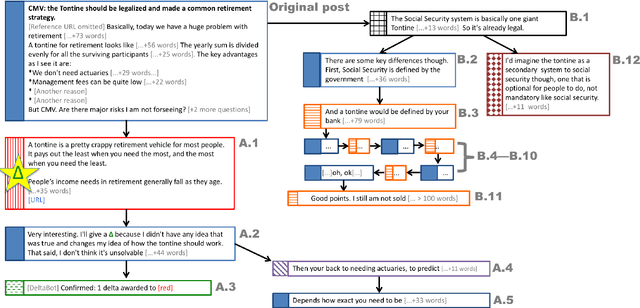

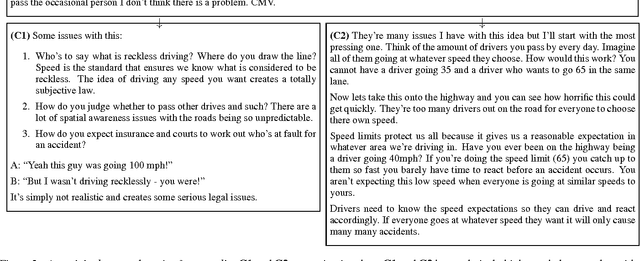
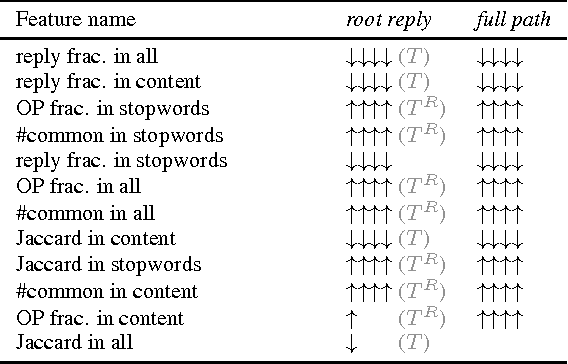
Abstract:Changing someone's opinion is arguably one of the most important challenges of social interaction. The underlying process proves difficult to study: it is hard to know how someone's opinions are formed and whether and how someone's views shift. Fortunately, ChangeMyView, an active community on Reddit, provides a platform where users present their own opinions and reasoning, invite others to contest them, and acknowledge when the ensuing discussions change their original views. In this work, we study these interactions to understand the mechanisms behind persuasion. We find that persuasive arguments are characterized by interesting patterns of interaction dynamics, such as participant entry-order and degree of back-and-forth exchange. Furthermore, by comparing similar counterarguments to the same opinion, we show that language factors play an essential role. In particular, the interplay between the language of the opinion holder and that of the counterargument provides highly predictive cues of persuasiveness. Finally, since even in this favorable setting people may not be persuaded, we investigate the problem of determining whether someone's opinion is susceptible to being changed at all. For this more difficult task, we show that stylistic choices in how the opinion is expressed carry predictive power.
All Who Wander: On the Prevalence and Characteristics of Multi-community Engagement
Mar 16, 2015



Abstract:Although analyzing user behavior within individual communities is an active and rich research domain, people usually interact with multiple communities both on- and off-line. How do users act in such multi-community environments? Although there are a host of intriguing aspects to this question, it has received much less attention in the research community in comparison to the intra-community case. In this paper, we examine three aspects of multi-community engagement: the sequence of communities that users post to, the language that users employ in those communities, and the feedback that users receive, using longitudinal posting behavior on Reddit as our main data source, and DBLP for auxiliary experiments. We also demonstrate the effectiveness of features drawn from these aspects in predicting users' future level of activity. One might expect that a user's trajectory mimics the "settling-down" process in real life: an initial exploration of sub-communities before settling down into a few niches. However, we find that the users in our data continually post in new communities; moreover, as time goes on, they post increasingly evenly among a more diverse set of smaller communities. Interestingly, it seems that users that eventually leave the community are "destined" to do so from the very beginning, in the sense of showing significantly different "wandering" patterns very early on in their trajectories; this finding has potentially important design implications for community maintainers. Our multi-community perspective also allows us to investigate the "situation vs. personality" debate from language usage across different communities.
A Corpus of Sentence-level Revisions in Academic Writing: A Step towards Understanding Statement Strength in Communication
May 31, 2014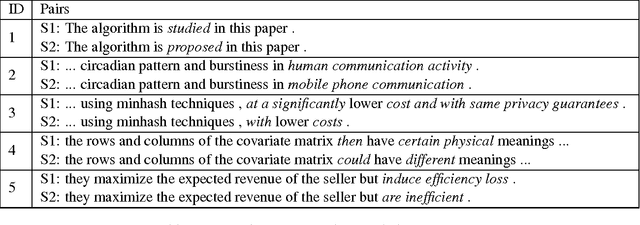
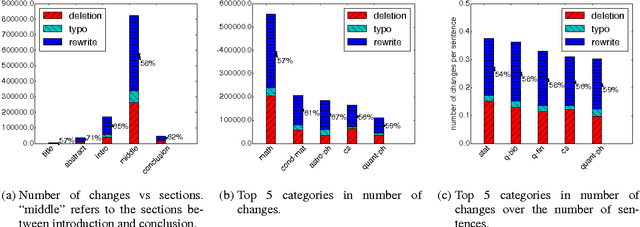

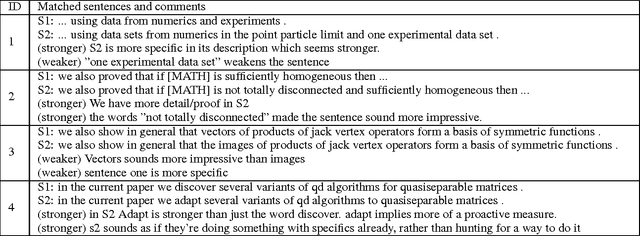
Abstract:The strength with which a statement is made can have a significant impact on the audience. For example, international relations can be strained by how the media in one country describes an event in another; and papers can be rejected because they overstate or understate their findings. It is thus important to understand the effects of statement strength. A first step is to be able to distinguish between strong and weak statements. However, even this problem is understudied, partly due to a lack of data. Since strength is inherently relative, revisions of texts that make claims are a natural source of data on strength differences. In this paper, we introduce a corpus of sentence-level revisions from academic writing. We also describe insights gained from our annotation efforts for this task.
The effect of wording on message propagation: Topic- and author-controlled natural experiments on Twitter
May 06, 2014
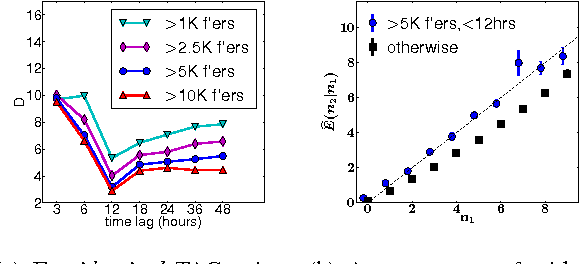

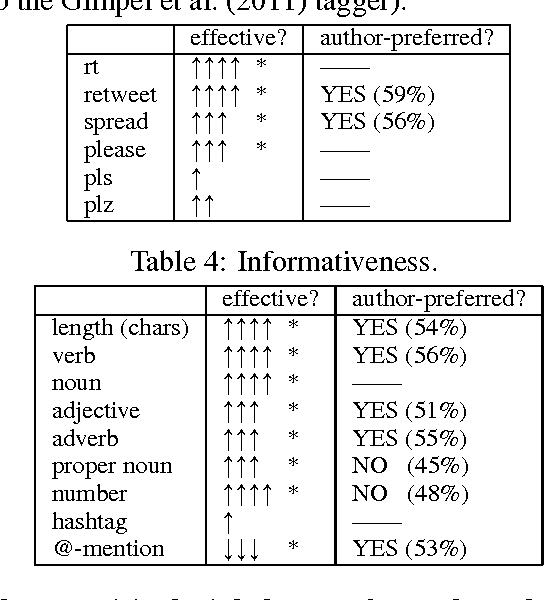
Abstract:Consider a person trying to spread an important message on a social network. He/she can spend hours trying to craft the message. Does it actually matter? While there has been extensive prior work looking into predicting popularity of social-media content, the effect of wording per se has rarely been studied since it is often confounded with the popularity of the author and the topic. To control for these confounding factors, we take advantage of the surprising fact that there are many pairs of tweets containing the same url and written by the same user but employing different wording. Given such pairs, we ask: which version attracts more retweets? This turns out to be a more difficult task than predicting popular topics. Still, humans can answer this question better than chance (but far from perfectly), and the computational methods we develop can do better than both an average human and a strong competing method trained on non-controlled data.
Get out the vote: Determining support or opposition from Congressional floor-debate transcripts
Jun 06, 2012
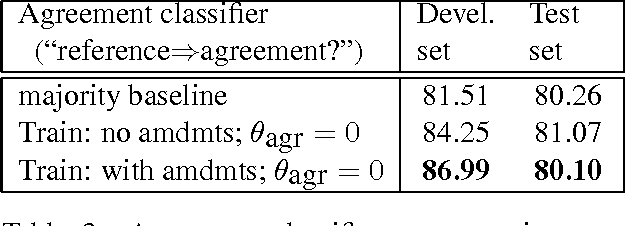

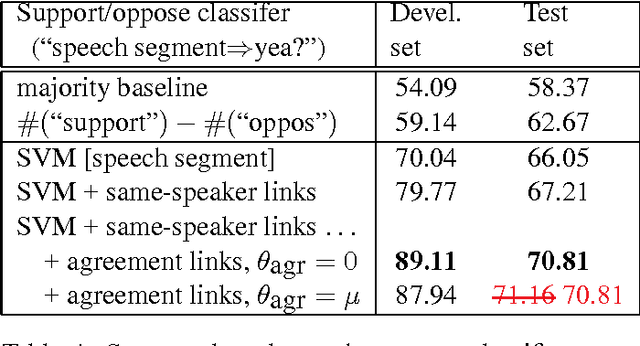
Abstract:We investigate whether one can determine from the transcripts of U.S. Congressional floor debates whether the speeches represent support of or opposition to proposed legislation. To address this problem, we exploit the fact that these speeches occur as part of a discussion; this allows us to use sources of information regarding relationships between discourse segments, such as whether a given utterance indicates agreement with the opinion expressed by another. We find that the incorporation of such information yields substantial improvements over classifying speeches in isolation.
Hedge detection as a lens on framing in the GMO debates: A position paper
Jun 05, 2012
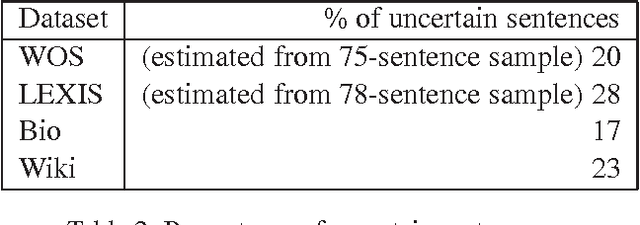
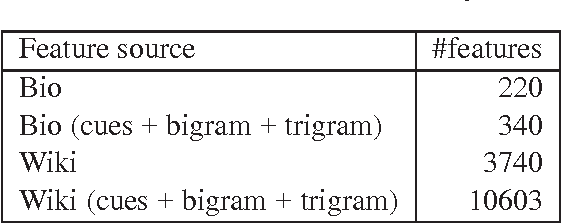
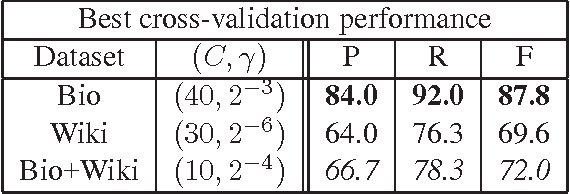
Abstract:Understanding the ways in which participants in public discussions frame their arguments is important in understanding how public opinion is formed. In this paper, we adopt the position that it is time for more computationally-oriented research on problems involving framing. In the interests of furthering that goal, we propose the following specific, interesting and, we believe, relatively accessible question: In the controversy regarding the use of genetically-modified organisms (GMOs) in agriculture, do pro- and anti-GMO articles differ in whether they choose to adopt a "scientific" tone? Prior work on the rhetoric and sociology of science suggests that hedging may distinguish popular-science text from text written by professional scientists for their colleagues. We propose a detailed approach to studying whether hedge detection can be used to understanding scientific framing in the GMO debates, and provide corpora to facilitate this study. Some of our preliminary analyses suggest that hedges occur less frequently in scientific discourse than in popular text, a finding that contradicts prior assertions in the literature. We hope that our initial work and data will encourage others to pursue this promising line of inquiry.
You had me at hello: How phrasing affects memorability
Apr 30, 2012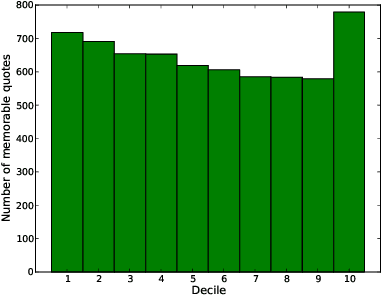

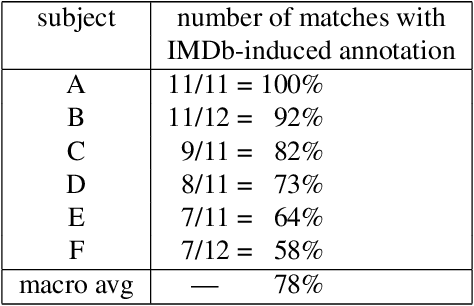
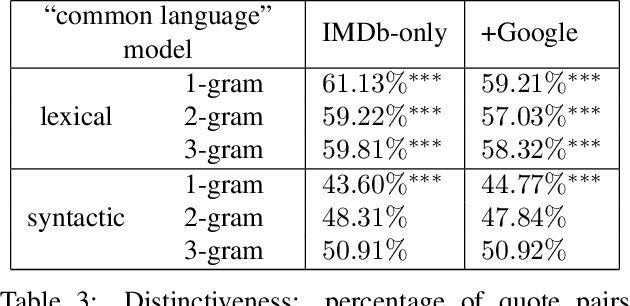
Abstract:Understanding the ways in which information achieves widespread public awareness is a research question of significant interest. We consider whether, and how, the way in which the information is phrased --- the choice of words and sentence structure --- can affect this process. To this end, we develop an analysis framework and build a corpus of movie quotes, annotated with memorability information, in which we are able to control for both the speaker and the setting of the quotes. We find that there are significant differences between memorable and non-memorable quotes in several key dimensions, even after controlling for situational and contextual factors. One is lexical distinctiveness: in aggregate, memorable quotes use less common word choices, but at the same time are built upon a scaffolding of common syntactic patterns. Another is that memorable quotes tend to be more general in ways that make them easy to apply in new contexts --- that is, more portable. We also show how the concept of "memorable language" can be extended across domains.
Echoes of power: Language effects and power differences in social interaction
Apr 13, 2012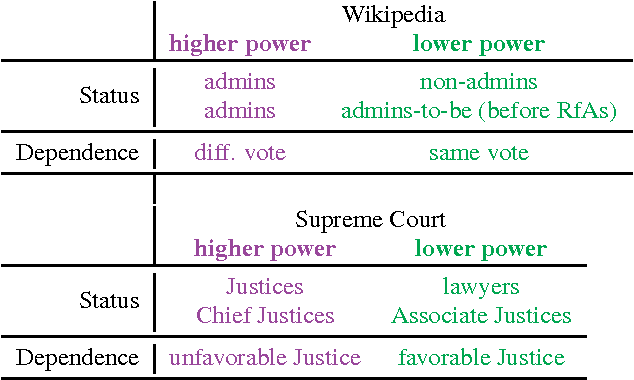
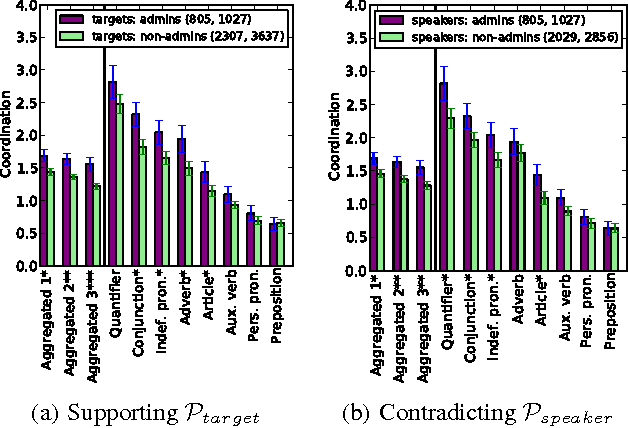
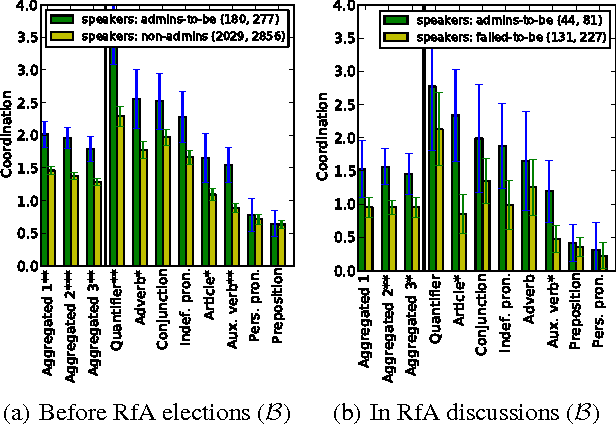

Abstract:Understanding social interaction within groups is key to analyzing online communities. Most current work focuses on structural properties: who talks to whom, and how such interactions form larger network structures. The interactions themselves, however, generally take place in the form of natural language --- either spoken or written --- and one could reasonably suppose that signals manifested in language might also provide information about roles, status, and other aspects of the group's dynamics. To date, however, finding such domain-independent language-based signals has been a challenge. Here, we show that in group discussions power differentials between participants are subtly revealed by how much one individual immediately echoes the linguistic style of the person they are responding to. Starting from this observation, we propose an analysis framework based on linguistic coordination that can be used to shed light on power relationships and that works consistently across multiple types of power --- including a more "static" form of power based on status differences, and a more "situational" form of power in which one individual experiences a type of dependence on another. Using this framework, we study how conversational behavior can reveal power relationships in two very different settings: discussions among Wikipedians and arguments before the U.S. Supreme Court.
User-level sentiment analysis incorporating social networks
Sep 27, 2011
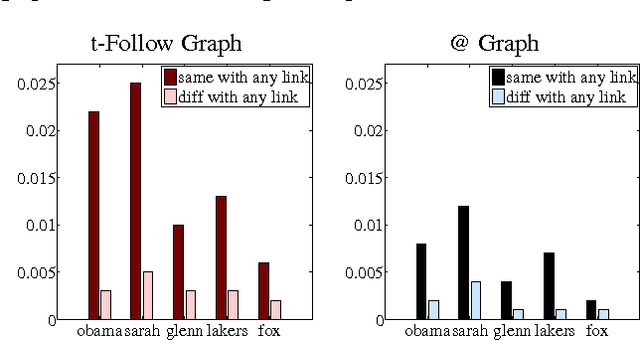

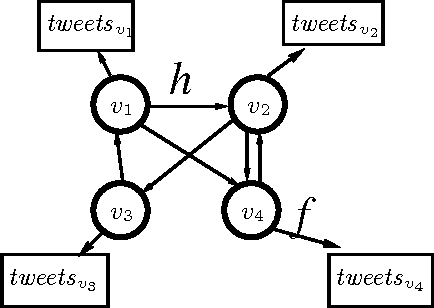
Abstract:We show that information about social relationships can be used to improve user-level sentiment analysis. The main motivation behind our approach is that users that are somehow "connected" may be more likely to hold similar opinions; therefore, relationship information can complement what we can extract about a user's viewpoints from their utterances. Employing Twitter as a source for our experimental data, and working within a semi-supervised framework, we propose models that are induced either from the Twitter follower/followee network or from the network in Twitter formed by users referring to each other using "@" mentions. Our transductive learning results reveal that incorporating social-network information can indeed lead to statistically significant sentiment-classification improvements over the performance of an approach based on Support Vector Machines having access only to textual features.
Chameleons in imagined conversations: A new approach to understanding coordination of linguistic style in dialogs
Jun 15, 2011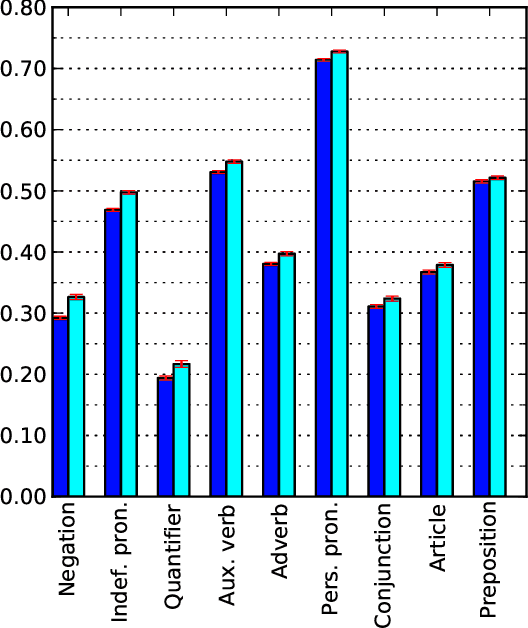
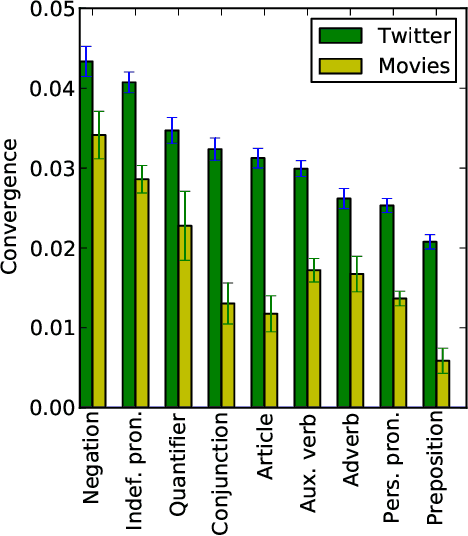
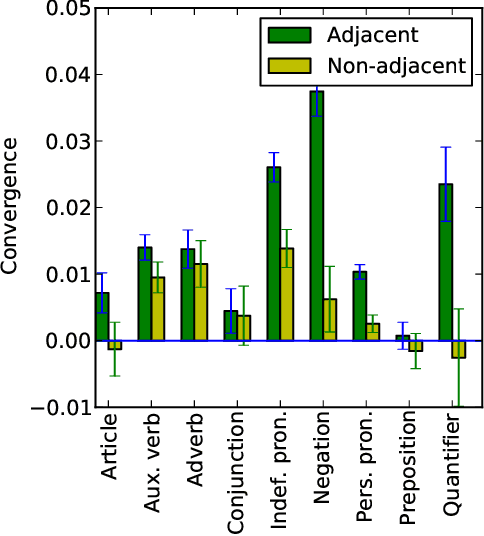
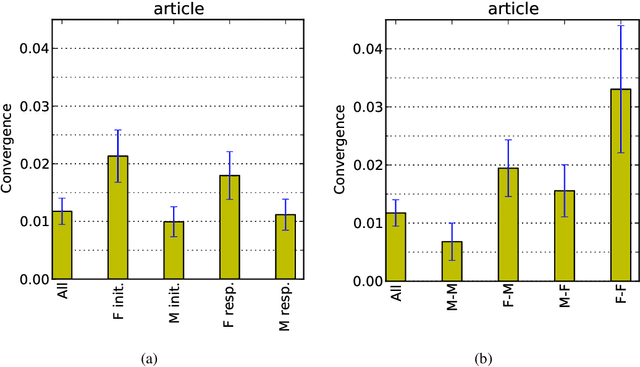
Abstract:Conversational participants tend to immediately and unconsciously adapt to each other's language styles: a speaker will even adjust the number of articles and other function words in their next utterance in response to the number in their partner's immediately preceding utterance. This striking level of coordination is thought to have arisen as a way to achieve social goals, such as gaining approval or emphasizing difference in status. But has the adaptation mechanism become so deeply embedded in the language-generation process as to become a reflex? We argue that fictional dialogs offer a way to study this question, since authors create the conversations but don't receive the social benefits (rather, the imagined characters do). Indeed, we find significant coordination across many families of function words in our large movie-script corpus. We also report suggestive preliminary findings on the effects of gender and other features; e.g., surprisingly, for articles, on average, characters adapt more to females than to males.
* data available at http://www.cs.cornell.edu/~cristian/movies
 Add to Chrome
Add to Chrome Add to Firefox
Add to Firefox Add to Edge
Add to Edge